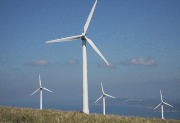 David Appleyard, conference director at Renewable Energy World Europe (REWE), examines the transformation of renewables from niche interest to major driver in the global energy arena, highlighting some of the key industry issues
David Appleyard, conference director at Renewable Energy World Europe (REWE), examines the transformation of renewables from niche interest to major driver in the global energy arena, highlighting some of the key industry issues
Government and industry are taking a more strategic approach to renewable energy technologies as they look to combat climate change, ensure security of energy supply and drive economic growth.
Renewable sources of energy such as hydro, wind, solar and biomass have been at the forefront of the European energy industry in recent years. Climate change has moved up the policy agenda as governments look to cut greenhouse gas emissions, reduce energy consumption and ensure security of supply in the face of increasing demand from consumers and industry.
According to EIA (the US Energy Information Administration), total world consumption of marketed energy will increase by 49% between 2007 to 2035, with renewables expected to be the fastest growing source of world energy.
Climate change initiatives have driven growth in the renewable market. The Kyoto Protocol, agreed in 1997, set out specific commitments by developed countries to reduce emissions by an average of 5.2% below 1990 levels between 2008 and 2012. Meanwhile, the binding EU wide target to source 20% of Europe’s energy needs from renewables by 2020 has played a major role in elevating the importance and development of renewable energy.
However, the growing use of renewables in the energy mix poses new challenges in terms of security of supply because they often generate intermittent power. As a result, balancing demand and supply on the grid becomes more complex, which has driven interest in the smart grid concept but has yet to see widespread adoption. Financing generally remains a major challenge for the renewable sector and other clean energy projects.
 Renewable evolution
Renewable evolution
Unsurprisingly, the political context outlined above has contributed to both new and traditional renewable technologies making inroads into the energy mix.
REMIPEG (Renewable Electricity Market, Installed Power and Annual Electricity Generation), Lahmeyer International’s renewable energy data bank, suggests that renewable capacity and power generation continues to be dominated by hydro-power, of which approximately 997GW has been installed.
However, it is not just hydro-power that is experiencing growth. According to BTM Consult ApS, wind power capacity is expected to grow to 447GW within five years and to nearly 1,000GW over ten years, to meet 8.4% of the world’s electricity demand.
Although the whole wind energy market is still heavily dominated by onshore projects, in 2010, Europe experienced a 50% growth in the offshore wind market, with most of the planned development being installed in the Baltic and North Sea regions. The European Wind Energy Association (EWEA) predicts that by the end of 2020, there will be circa 40GW of installed offshore wind energy in Europe.
Integration and finance
One of the biggest challenges now facing the renewable industry is how to integrate the increasing amounts of intermittent power sources like solar and wind into the electricity grid.
National incentive schemes to accelerate the grid integration of renewables have already been put in place across many European countries. The installation of smart meters is being taken up by organisations as a tangible way to monitor and manage consumption, with access to flexible tariffs and better visibility on where savings can be made. Smart grids are expected to transform today’s power distribution systems into flexible, interactive, bi-directional systems that distribute electricity more efficiently.
Financing renewable technologies will undoubtedly play a key part in creating a sustainable future for renewables, from funding new projects to ensuring long term commercial viability. Throughout Europe, investment in new renewable resources represents a growing sector of activity for lenders. As track record and experience increases, lenders can be expected to commit an increasing share of their balance sheets to financing renewable projects and be willing to expand on the range of technologies they finance.
Gaining end user acceptance
The adoption of renewables by both businesses and consumers is clearly gathering momentum, driven largely by financial incentives in the form of government backed schemes such as Feed-in-Tariffs (FiTs) which guarantee a minimum payment for all electricity generated by a ‘microgeneration’ system as well as a separate payment for the electricity exported to the grid.
FiTs are proving to be extremely successful in the EU for promoting the adoption of renewable technologies such as small scale wind and solar photovoltaic (PV). However, ironically, in Germany and the UK, the solar PV industry appears to have become a victim of its own success, where the popularity of solar PV FiTs has led to the government reducing the FiTs rate. Nevertheless, the success of FiTs demonstrates how renewables can offer a commercially viable solution not just for industry, but for end users too.


